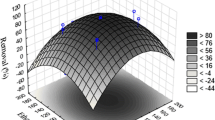Abstract
A rotating disk apparatus was used to investigate the biodegradation of PAHs from non-aqueous phase liquids to solutions of Brij 35. The mass transfer of PAHs in absence of surfactant solution was not large enough to replenish the degraded PAHs. The addition of surfactant resulted in an overall enhancement of biodegradation rates compared to that observed in pure aqueous solution. This is because surfactant partition significant amount of PAHs into the bulk phase, where uptake occurs but the supply of PAHs to the aqueous phase through micellar solubilization at latter period limited biodegradation rates. It was demonstrated the relationship between biodegradation rate and surfactant dose and the mechanisms controlling the mass transfer of PAH from NAPLs. The satisfactory comparison of the experimental data with the predictions of a model, which parameters were determined from independent solubilization and dissolution experiments and based on the main assumption that the solutes must be present in the true aqueous phase to be degraded, allows us to conclude the absence of direct uptake of PAHs by bacteria.





Similar content being viewed by others
References
Peters CA, Luthy RG (1993) Coal-tar dissolution in water-miscible solvents: experimental evaluation. Environ Sci Technol 27:2831–2843
Cerniglia CE (1990) The use of a Mycobacterium sp in the remediation of polycyclic aromatic hydrocarbon wastes, Draft report: Biological remediation of contaminated sediments, with special emphasis on the great lakes, Manitowoc, Wisc., 17–19 July, pp 90–106
Grimberg SJ, Stringfellow WT, Aitken MD (1996) Quantifying the biodegradation of phenanthrene by Pseudomonas stutzeri P16 in the presence of a nonionic surfactant. Appl Environ Microbiol 62:2387–2392
Volkering F, Breure AM, van Andel JG, Rulkens WH (1995) Influence of nonionic surfactants on bioavailability and biodegradation of polycyclic aromatic hydrocarbon. Appl Environ Microbiol 61:1699–1705
Laha S, Luthy RG (1992) Effects of non-ionic surfactants on the solubilization and mineralization of phenanthrene in soil-water systems. Biotechnol Bioeng 40:1367–1380
Chaiko MA, Nagarajan R, Ruckenstein E (1984) Solubilization of single-component and binary mixtures of hydrocarbons in aqueous micellar solutions. J Colloid Interface Sci 99:168–182
Nagarajan R, Chaiko MA, Ruckenstein E (1998) Locus of solubilization of benzene in surfactant micelle. J Phys Chem 88:2916–2922
Guha S, Jaffé PR, Peters CA (1998) Solubilization of PAH mixtures by a nonionic surfactant. Environ Sci Technol 32:930–935
Hill A, Ghoshal S (2002) Micellar solubilization of naphthalene and phenanthrene from non aqueous phase liquids. Environ Sci Technol 36:3901–3907
Bosma NP, Middeldorp PJ, Zehnder JB (1997) Mass transfer limitation of biotransformation: quantifying bioavailability. Environ Sci Technol 31:248
Carroll BJ (1981) The kinetics of solubilization of nonpolar oils by nonionic surfactant solutions. Colloid Interface Sci 79:126–135
Chan AF, Evans DF, Cussler EL (1976) Explaining solubilization kinetics. AIChE J 22:1006–1012
Grimberg SJ, Nagel J, Aitken MD (1995) Kinetics of phenanthrene dissolution into water in the presence of nonionic surfactants. Environ Sci Technol 29:1480–1487
Cussler EL (1997) Diffusion, mass transfer in fluid systems, 2nd edn. 580 pp, Cambridge University Press, NY
Huang C, Evans DF, Cussler EL (1981) Linoleic acid solubilization with a spinning liquid disc. J Colloid Interface Sci 82:499
Weiss J, Coupland JN, Brathwaite D, McClements DJ (1997) Influence of molecular structure of hydrocarbon emulsion droplets on their solubilization in nonionic surfactant micelles. Colloids Surf A Physico Eng Asp 121:53
Bernardez LA, Ghoshal S (2008) Solubilization kinetics for polycyclic aromatic hydrocarbons transferring from a non-aqueous phase liquid to non-ionic surfactant solutions. J Colloid Interface Sci 320:298–306
Bernardez LA (2008) Dissolution of polycyclic aromatic hydrocarbons from a non-aqueous phase liquid into a surfactant solution using a rotating disk apparatus. Colloids Surf A Physicochem Eng Asp 320:175–182
Thiem A, Stieber M, Werner P, Frimmel FH (1997) Surfactant-enhanced mobilization and biodegradation of polycyclic aromatic hydrocarbons in manufactured gas plant soil. Environ Sci Technol 31:2570–2576
Bernardez LA, Ghoshal S (2004) Selective solubilization of PAHs from a multicomponent NAPL into nonionic surfactant micelles. Environ Sci Technol 38:5878–5887
Bernardez LA (2008) Investigation on the locus of solubilization of polycyclic aromatic hydrocarbons in non-ionic surfactant micelles with 1H NMR spectroscopy. Colloids and Surf A Physicochem Eng Asp 324:71–78
Rosen MJ (1989) Surfactants and interfacial phenomena, 2nd edn. 431 pp, Wiley, London
Aitken MD, Stringfellow WT, Nagel RD, Kazunga C, Chen SH (1998) Characteristics of phenanthrene-degrading bacteria isolates from soils contaminated with polycyclic aromatic hydrocarbons. Can J Microbiol 44:743–752
Stringfellow WT, Aitken MD (1994) Comparative physiology of phenanthrene degradation by two dissimilar Pseudomonas isolated from a creosote-contaminated soil. Can J Microbiol 40:432–438
Stringfellow WT, Aitken MD (1995) Competitive metabolism of naphthalene, methylnaphthalenes, and fluorine by phenanthrene-degrading Pseudomonas. Appl Environ Microbiol 61:357–362
Stringfellow WT, Alvarez-Cohen L (1999) Evaluating the relationship between the sorption of PAHs to bacterial biomass and biodegradation. Water Res 33:2535–2544
Schwarzenbach RP, Gschwend PM, Imboden DM (1993) Environmental organic chemistry. Wiley, New York
Mukherji S, Peters CA, Weber WJ Jr (1997) Mass transfer of polynuclear aromatic hydrocarbons from complex DNAPL mixtures. Environ Sci Technol 31:416–423
Chiou CT, Schmedding DW (1982) Partitioning of organic compounds in octanol-water system. Environ Sci Technol 16:4–10
Acknowledgments
Funding for this research was provided by Natural Sciences and Engineering Research Council (NSERC) of Canada, National Council of Science and Technology (CNPq, Brazil) and Fonds Québécois de la Recherche sur la Nature et les Technologies (FQNRT). The author also thanks Professor Stephan Grimberg of Clarkson University for providing the strain and Professor Subhasis Ghoshal of McGill University for his valuable comments.
Author information
Authors and Affiliations
Corresponding author
Rights and permissions
About this article
Cite this article
Bernardez, L.A. A rotating disk apparatus for assessing the biodegradation of polycyclic aromatic hydrocarbons transferring from a non-aqueous phase liquid to solutions of surfactant Brij 35. Bioprocess Biosyst Eng 32, 415–424 (2009). https://doi.org/10.1007/s00449-008-0261-1
Received:
Accepted:
Published:
Issue Date:
DOI: https://doi.org/10.1007/s00449-008-0261-1




